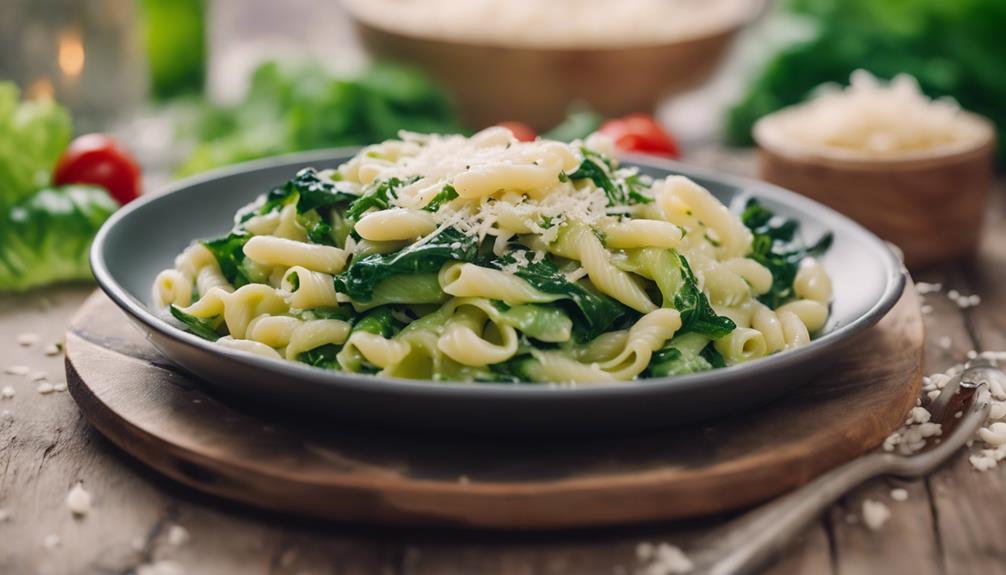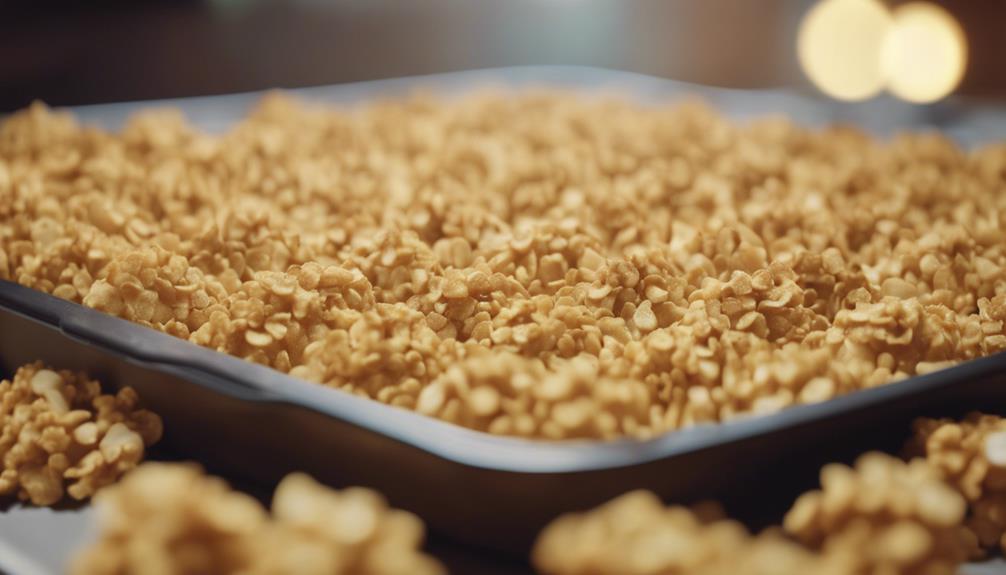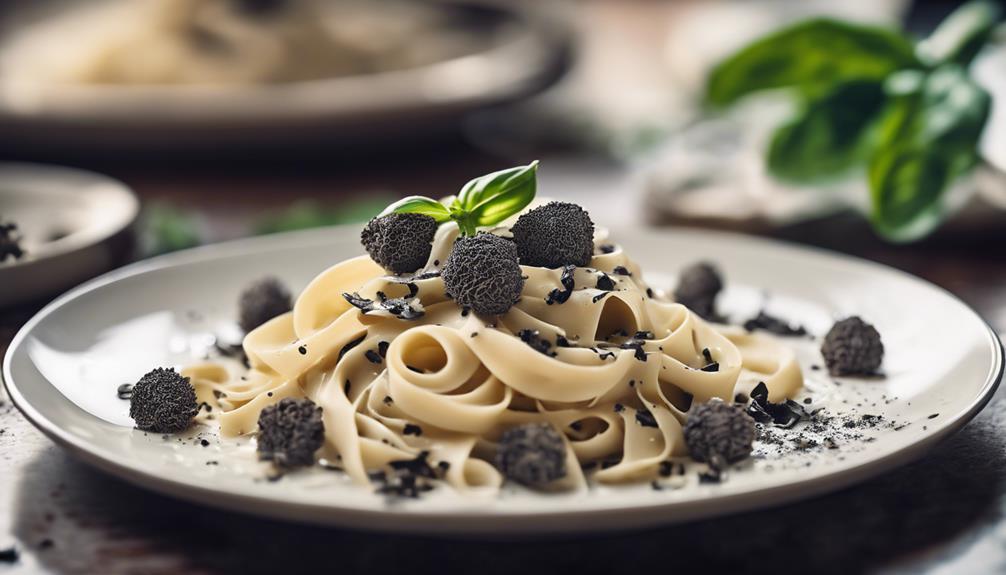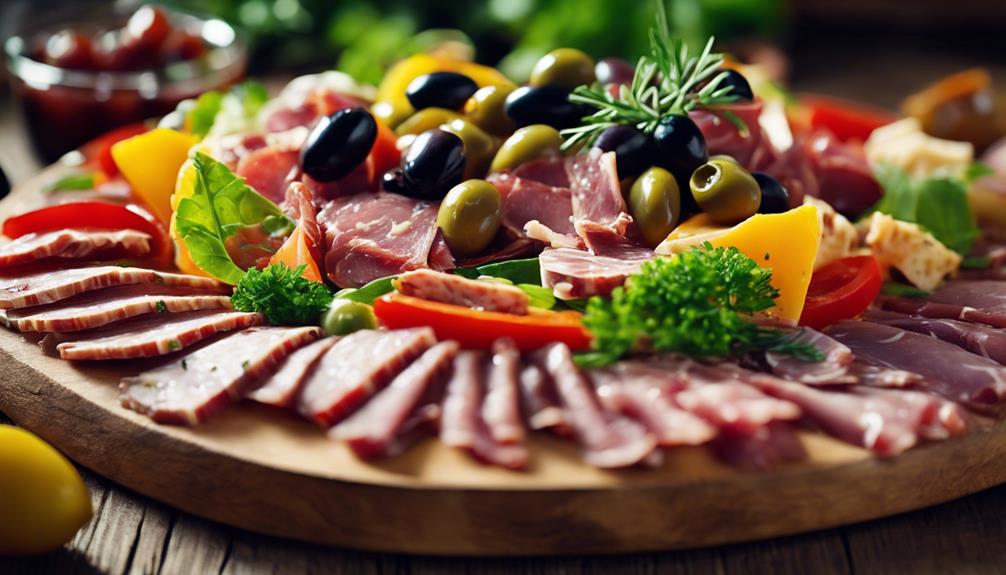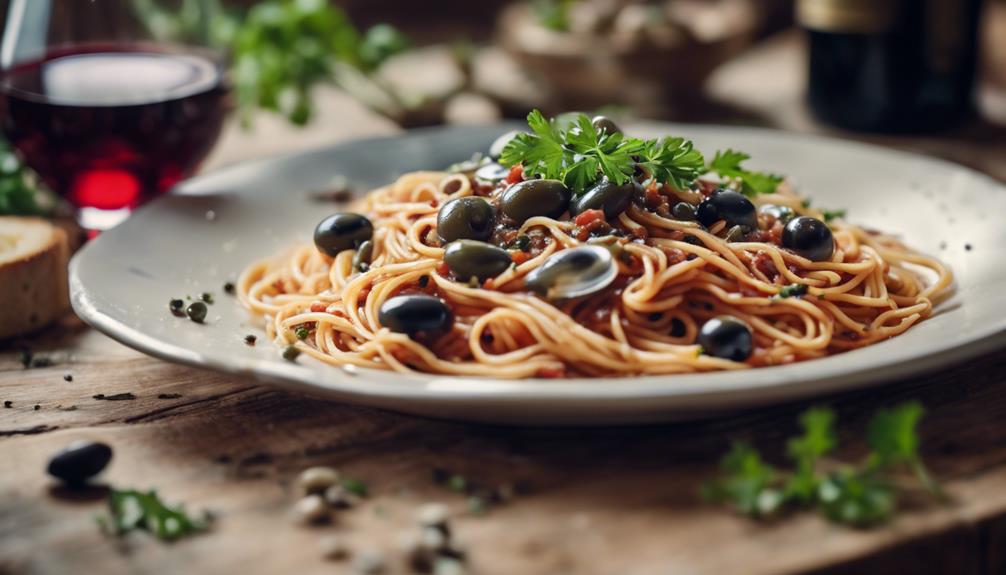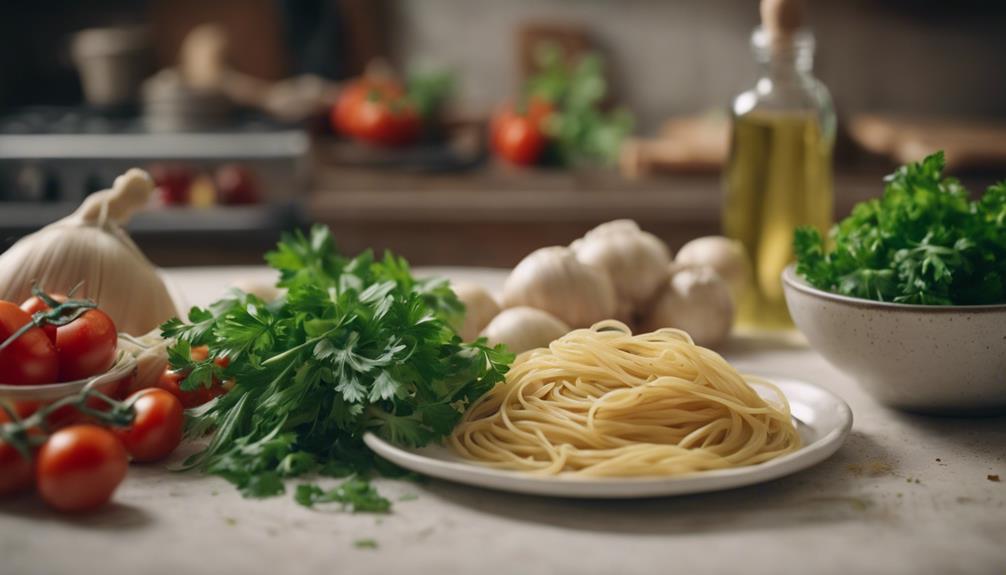Indulge in the nutritious mixture of escarole and beans pasta, a classic Italian dish known for its health benefits and rich flavors. Escarole is rich in essential vitamins A and K, while beans provide protein and fiber, promoting overall well-being. High-quality Italian sausage adds authenticity to the dish, and whole-wheat penne increases its nutritional value. Sauteed onions and garlic create a delicious base, complemented by fragrant herbs like parsley and basil. Complete your meal with pecorino romano cheese for an indulgent finishing touch. Master your cooking skills, serve in cozy bowls, and enjoy the perfect combination of ingredients. Explore further for an incredibly satisfying dining experience.
Key Takeaways
- Escarole and beans pasta is a nutritious, low-calorie meal with essential vitamins and fiber.
- Quality ingredients like Italian sausage and whole-wheat penne enhance flavors authentically.
- Incorporate aromatic onions, garlic, and herbs for depth of flavor in the dish.
- Consider vegetarian or vegan variations by substituting meat and dairy products.
- Sausage cooking techniques, like breaking into small pieces, ensure even distribution and flavor.
Benefits of Escarole in Pasta
Why is escarole a beneficial addition to pasta dishes?
Escarole, an Italian leafy green with a slightly bitter flavor, brings a host of advantages to your pasta recipes. To begin with, escarole is packed with essential vitamins A and K, important for eye health and bone strength. Its high fiber content not only aids in digestion but also promotes gut health. Additionally, being a low-calorie vegetable, escarole is an excellent choice for weight management.
The bitterness of escarole adds a unique depth of flavor to pasta dishes, balancing out the richness of other ingredients. By including escarole in your pasta recipes, you're not just enhancing the taste but also incorporating a significant dose of antioxidants, which can help boost your overall health and immunity.
Ingredient Spotlight: Cannellini Beans
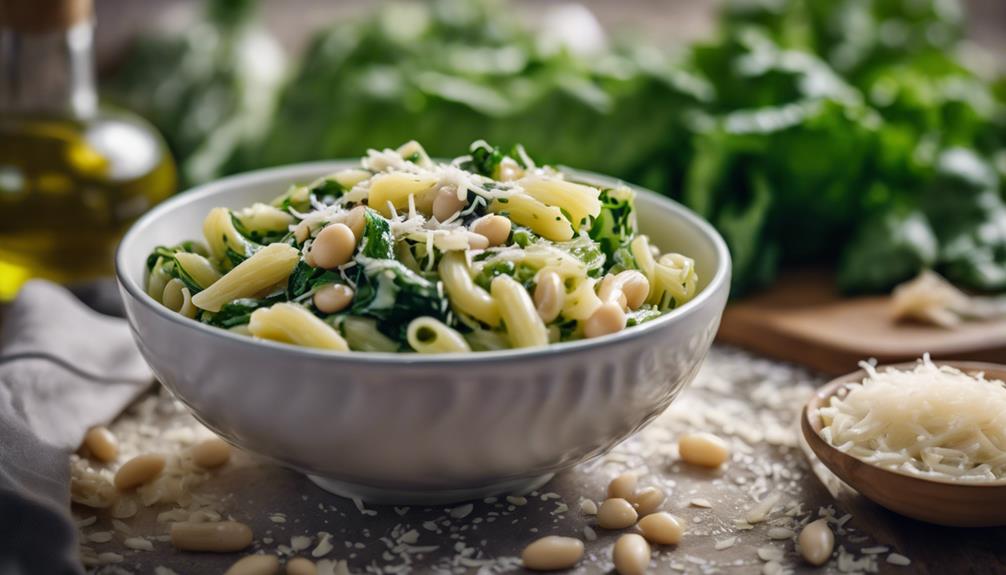
Cannellini beans, popular in Italian cuisine, are large, creamy white beans known for their rich protein and fiber content. These beans, also called white kidney beans, offer a mild flavor and a smooth, buttery texture when cooked. They are a versatile ingredient that is commonly used in soups, salads, and pasta dishes like the traditional Escarole and Beans Pasta. Cannellini beans are not only delicious but also packed with essential nutrients such as iron and folate. Their ability to hold shape well makes them ideal for adding creaminess to various recipes.
Let's dive deeper into the nutritional value of Cannellini beans with the table below:
| Nutrient | Amount per 1 cup (about 182g) |
|---|---|
| Protein | 15.4 grams |
| Fiber | 6.2 grams |
| Iron | 2.0 milligrams |
Incorporating these creamy white beans into your Italian pasta dishes not only enhances the flavor but also boosts the nutritional value, especially when paired with leafy greens like escarole to balance out the bitterness and add a pop of color to your meal.
Cooking Tips for Perfect Pasta
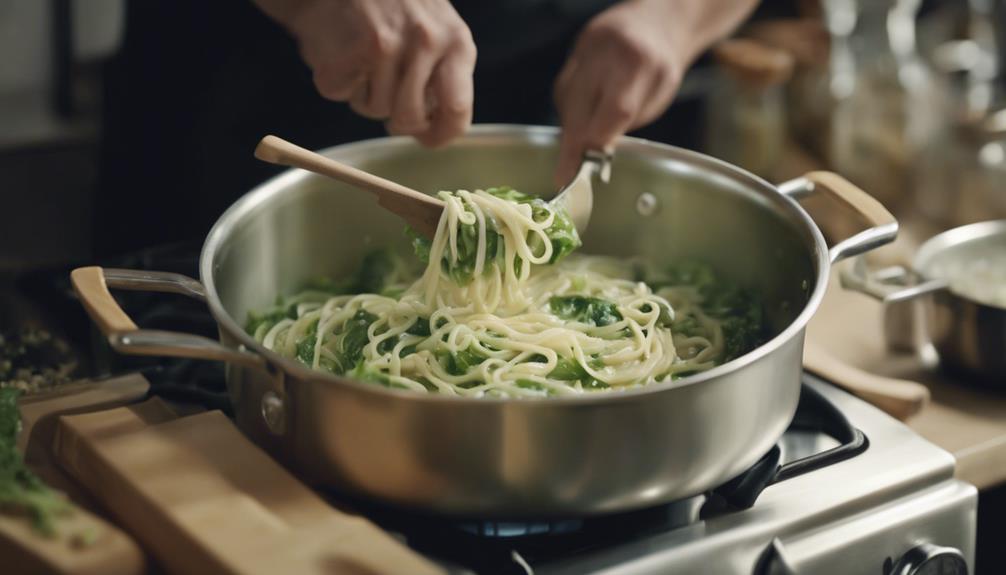
Consider reserving a cup of pasta cooking water to adjust the consistency of the sauce as needed for a perfectly cooked pasta dish.
When preparing pasta with escarole and bitter greens, keep a close watch on the cooking time to guarantee the greens retain their vibrant color and slight crunch.
Opt for quality Italian sausage to infuse the dish with authentic flavors that complement the earthy greens.
Utilize a non-stick skillet for even cooking and to prevent any sticking mishaps that may maintain the dish's balance.
Breaking the sausage into bite-sized pieces allows for better distribution throughout the pasta, enhancing each bite with a burst of savory goodness.
For an indulgent finish, grate your favorite cheese generously over the pasta before serving, adding a rich and creamy touch that ties all the flavors together harmoniously.
Vegetarian and Vegan Variations
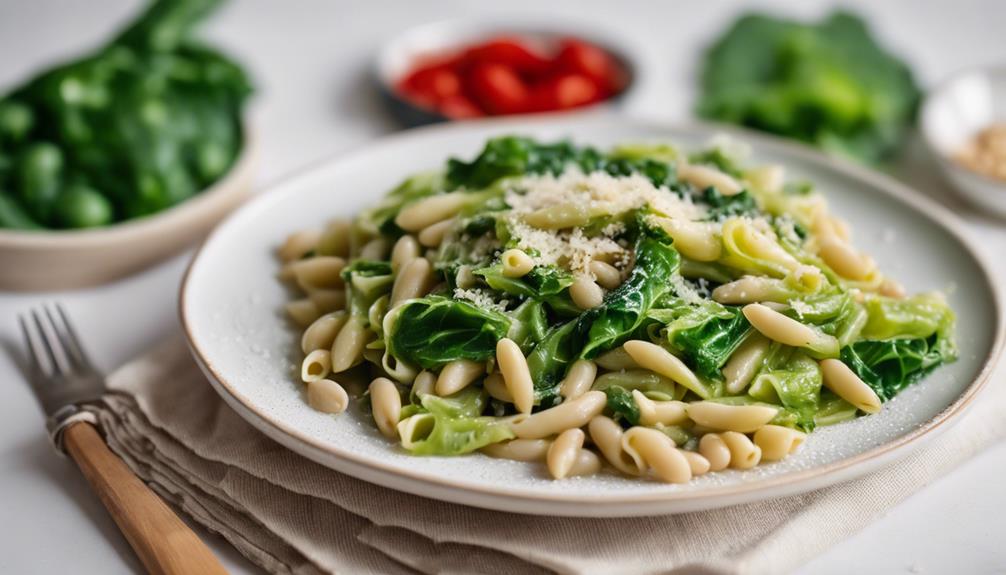
To cater to vegetarian and vegan preferences, consider substituting traditional meat-based ingredients with plant-based alternatives for a cruelty-free twist on the classic Escarole and Beans Pasta dish. Vegetarians can swap Italian chicken sausage for plant-based options like vegan sausage or tempeh, creating a meat-free version of the meal.
For a vegan adaptation, use vegetable broth instead of chicken broth to uphold a plant-based profile without sacrificing flavor. Opt for dairy-free cheese alternatives such as nutritional yeast or vegan parmesan to sprinkle on top, offering vegans a dairy-free option.
Experiment with various leafy greens like spinach, kale, or Swiss chard in place of escarole to personalize the dish based on preferences or seasonal availability. By swapping out traditional ingredients with plant-based alternatives and adjusting seasonings, vegans can relish this hearty Italian meal in a way that aligns with their dietary choices.
Flavorful Base: Onions and Garlic
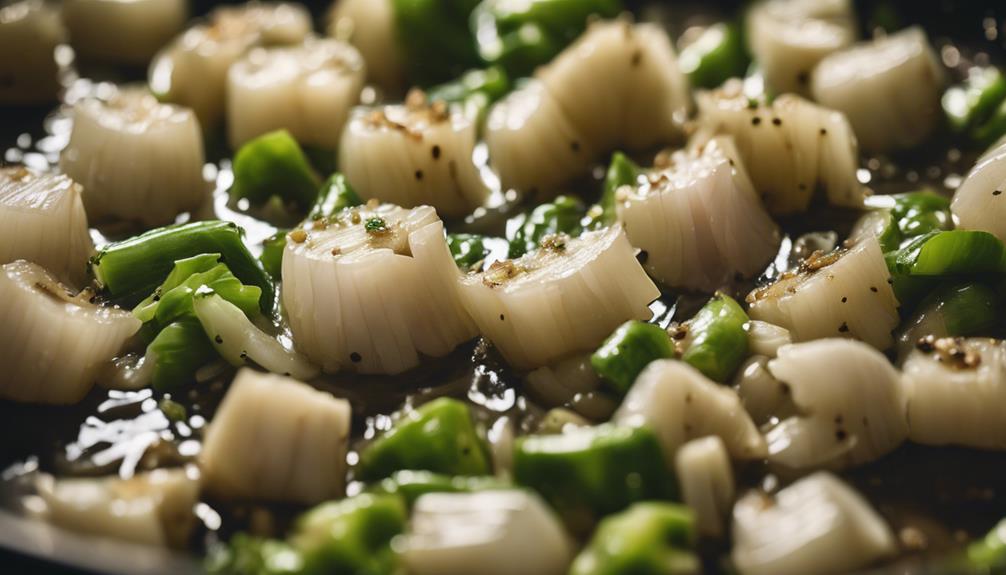
Onions and garlic play a significant role in elevating the flavors of the escarole and beans pasta dish. Aromatic onions add a sweet and savory note, while garlic contributes depth and complexity to the overall taste profile.
Together, these ingredients form a flavorful base that enhances the dish's richness and aroma.
Aromatic Onions Enhance
How do aromatic onions enhance the flavor profile of the escarole and beans pasta dish?
Aromatic onions play an essential role in elevating the taste experience of this hearty Italian meal. When sauteed to perfection, onions add a sweet and savory base that complements the bitterness of the escarole and the creaminess of the beans. Together with the sauteed garlic, these ingredients create a classic Italian flavor foundation, bringing depth and complexity to each bite.
The rich, aromatic undertones of the garlic infuse into the escarole and beans, enhancing the overall dish with their flavorful essence. As the onions and garlic meld together during the cooking process, they contribute significantly to the robust taste profile of the escarole and beans pasta, making it a truly satisfying and delicious meal.
Garlic Adds Depth
Sauteing garlic alongside onions creates a flavorful base that enhances the overall taste experience of the escarole and beans pasta dish.
The combination of garlic and onions, when carefully sautéed, forms a vital foundation for the recipe, infusing the dish with a delightful aroma and rich flavors.
The pungent and distinctive taste of garlic plays an essential role in balancing the slight bitterness of escarole, resulting in a harmonious blend of flavors that tantalize the palate.
By cooking garlic until golden in quality olive oil, its aromatic qualities are released, setting the stage for a delicious Italian-inspired meal.
The marriage of garlic, onions, and other aromatics in the sauté process creates a savory backdrop that complements the earthy notes of the beans and greens present in this traditional pasta dish.
As you start on preparing this hearty Italian meal, remember that the careful sautéing of garlic is a fundamental step in elevating the depth of flavors in the escarole and beans pasta.
How to Prep Sausage for Pasta

When prepping sausage for pasta, you should consider sausage selection tips, casing removal, and cooking techniques.
Choosing a lean sausage can reduce excess fat in the dish while still providing flavor. Remember to remove the casings and crumble the sausage into small pieces for even distribution throughout the pasta.
Sausage Selection Tips
For a healthier alternative with a flavorful kick, choose Italian chicken or turkey sausage, and remember to remove the casings before cooking for easy preparation in your Escarole and Beans Pasta.
When selecting the perfect sausage for your dish, keep in mind these tips:
- Lean Protein: Opt for Italian chicken or turkey sausage to add a lean protein source to your meal, reducing the overall fat content.
- Sausage Casings: Make sure to remove the casings before cooking to facilitate crumbling or slicing the sausage easily for incorporation into the pasta.
- Sweet or Spicy Sausage: Choose between sweet or spicy sausage based on your personal preference for flavor intensity, adding a tailored touch to your dish.
- Fully Cooked: Verify that the sausage is fully cooked before combining it with other ingredients in the skillet, ensuring a safe and delicious final result.
Sausage Casing Removal
To prepare sausage for pasta, begin by carefully removing the casing from Italian chicken or turkey sausage links. Gently squeeze the sausage out of the casing, making sure to discard the casing itself. This step is essential as it allows the sausage meat to be broken up and cooked in the skillet, resulting in a more uniform texture in the pasta dish.
By removing the casing, you enable the sausage flavor to infuse evenly throughout the entire dish, enhancing the overall taste. Properly prepping the sausage for pasta ensures that the meat cooks thoroughly and blends harmoniously with the other ingredients in the recipe.
Sausage Cooking Techniques
Consider carefully removing the casing from Italian chicken or turkey sausage links to guarantee a crumbled texture in your escarole and beans pasta dish.
Here are some tips for preparing sausage for your pasta:
- Break it Up: Once the casing is removed, break the sausage into small pieces while cooking. This will help evenly distribute the flavor throughout the dish.
- Lean Choice: Opt for lean Italian chicken or turkey sausage for a healthier alternative that still provides the delicious taste you desire in your pasta.
- Season Well: Before cooking, season the sausage with salt, pepper, and any desired herbs or spices. This step enhances the overall flavor profile of your pasta dish.
- Cook Thoroughly: Ensure the sausage is fully cooked before combining it with the escarole, beans, and pasta. This step is essential to prevent any food safety concerns from arising.
Nutritious Whole-Wheat Penne
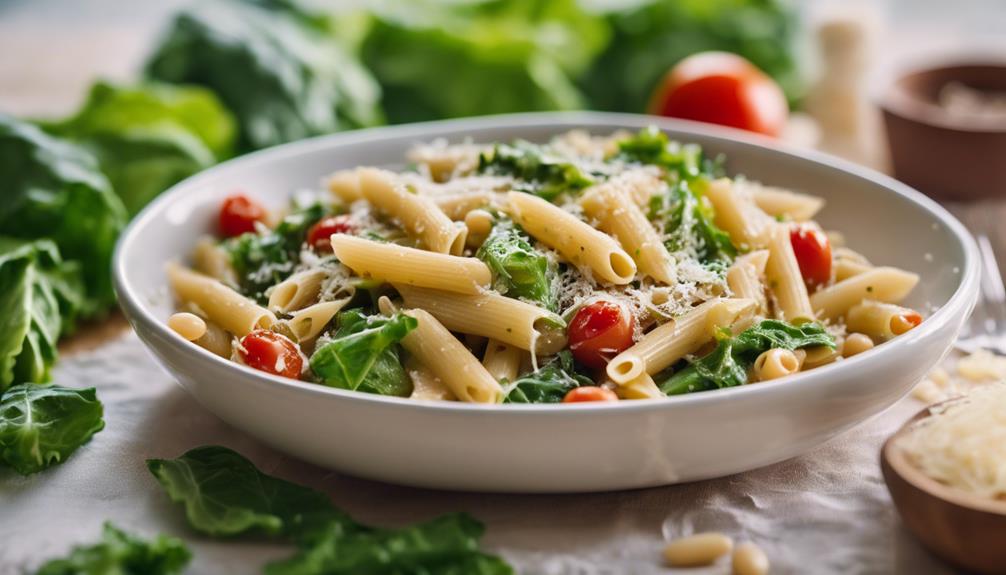
Opt for the nutritious whole-wheat penne when preparing the Escarole and Beans Pasta for a fiber-rich and flavorful twist. Whole-wheat penne is a wholesome choice packed with fiber and essential nutrients, offering a healthier option compared to traditional refined pasta. This pasta not only aids in digestion but also promotes a feeling of fullness, making it a satisfying addition to your meal. The nutty flavor and slightly chewy texture of whole-wheat penne enhance the overall dish, complementing the hearty flavors of escarole and beans in this Italian meal. By incorporating whole-wheat penne into your recipe, you elevate its nutritional value, creating a well-balanced and nourishing dish that embodies the essence of Italian cuisine.
| Nutritious Whole-Wheat Penne Facts |
|---|
| Rich in fiber and essential nutrients |
| Healthier alternative to refined pasta |
| Enhances the flavors of escarole and beans |
Enhancing Flavor With Herbs
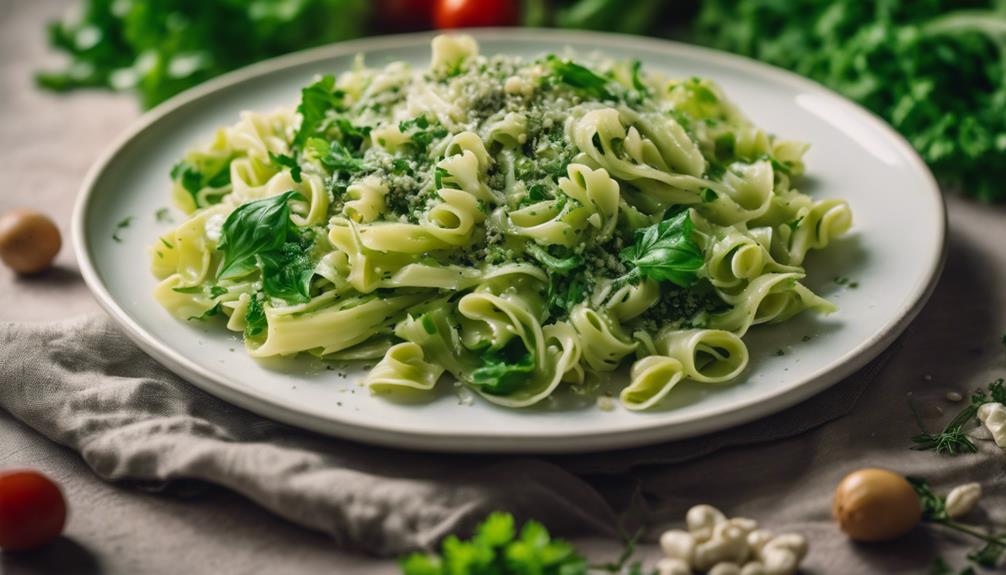
Enhance the flavor profile of your escarole and beans pasta by incorporating herbs like parsley, basil, and thyme. These herbs not only add depth and complexity to the dish but also provide a burst of invigorating and aromatic freshness, elevating the overall experience of your meal.
Here's how different herbs can enhance the flavor of your pasta:
- Parsley: Known for its bright and herbaceous taste, parsley brings a revitalizing element to the dish.
- Basil: With a sweet and slightly peppery flavor, basil complements the greens and beans, adding a layer of complexity to the pasta.
- Thyme: Offering a savory and earthy undertone, thyme pairs beautifully with the other ingredients, enhancing the overall savory profile of the dish.
- Experimentation: Don't be afraid to mix and match these herbs to find your perfect flavor combination. Trying different herb blends can take your escarole and beans pasta to a whole new level of deliciousness.
Serving Suggestions for Escarole Pasta
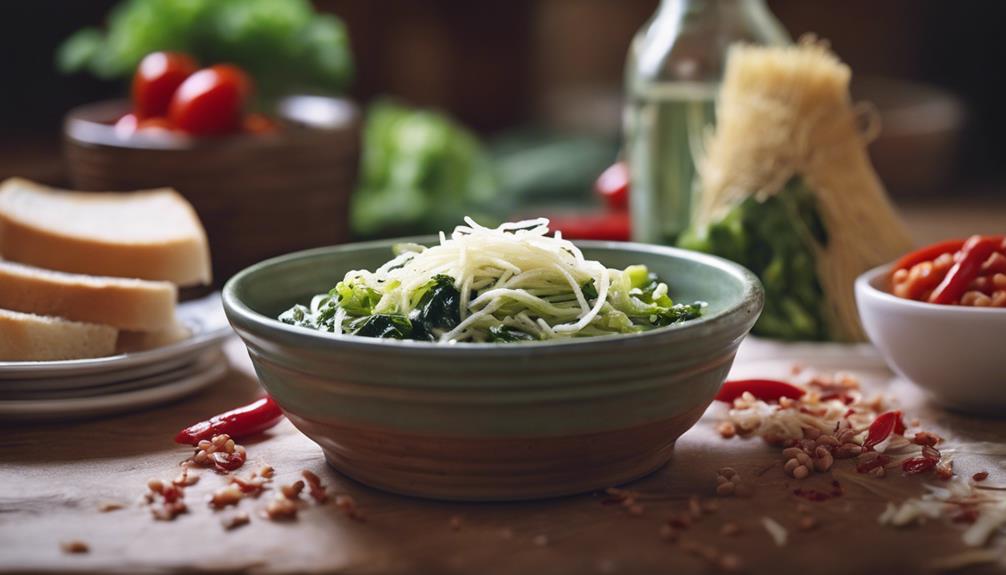
Serve your escarole and beans pasta in warm bowls to create a comforting and hearty dining experience. This Italian dish is perfect for those craving a nutritious meal that combines the goodness of greens and beans with the satisfying nature of pasta. To elevate the flavors, consider sprinkling grated pecorino romano cheese on top, adding a rich and savory touch to each bite. Whether served as a first course in a traditional Italian meal or as a robust main course, this hearty dish is sure to please your taste buds.
For a complete meal experience, pair your escarole pasta with some crusty bread or a fresh Italian green salad dressed in vinaigrette. This combination not only adds a variety of textures and flavors but also enhances the overall dining experience. Embrace the essence of Italian cuisine by savoring this hearty dish with these thoughtful serving suggestions.
| Serving Suggestions | Description |
|---|---|
| Crusty Bread | Perfect for dipping in sauce |
| Italian Green Salad | Invigorating side dish |
| Pecorino Romano Cheese | Adds a rich and savory flavor |
| Warm Bowls | Enhances the comforting experience |
Frequently Asked Questions
Are Escarole and Beans Good for You?
Yes, escarole and beans are good for you. They provide essential nutrients like vitamins, fiber, and protein, supporting overall health. Including them in your diet promotes satiety, aids digestion, and contributes to your well-being.
What Is Italian Escarole?
Italian escarole is a leafy green veggie with a slightly bitter taste. Rich in vitamins A and K, folate, and fiber, it's a nutritious choice. When cooked briefly, escarole's unique flavor shines. Enjoy this versatile green in various Italian dishes.
Why Is Escarole so Expensive?
Escarole can be pricier due to limited availability, seasonal factors, and high demand. Its labor-intensive production process and specialty or organic options also contribute to the higher cost. Despite this, its unique taste justifies the investment.
Is Escarole Seasonal?
Yes, escarole is seasonal. It thrives in cooler temperatures during the fall and winter months. For the best flavor and quality, look for fresh escarole at farmers' markets or grocery stores when it's in season.
Can Escarole and Beans Pasta be a Suitable Alternative to Sausage and Broccoli Rabe Pasta for a Hearty Italian Meal?
Looking for a hearty Italian meal without the heaviness of sausage and broccoli rabe pasta? Escarole and beans pasta could be the perfect alternative. With its satisfying combination of flavors and textures, this dish provides a healthier option while still delivering on that classic Italian comfort food experience.
Conclusion
To sum up, the fusion of escarole and beans in pasta offers a hearty and nutritious meal for all to enjoy. With the right ingredients and cooking techniques, you can create a flavorful dish that isn't only satisfying but also packed with essential nutrients.
Whether you choose to add sausage or keep it vegetarian, this Italian-inspired pasta is sure to please your taste buds and provide a wholesome dining experience. Try it today and savor the delicious flavors!
